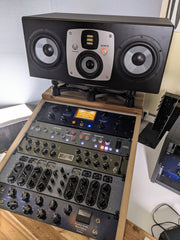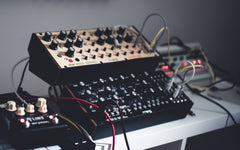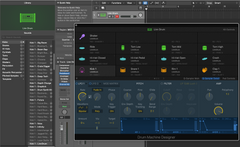How loud should your monitor speakers be for music production?

How loud should your monitor speakers be for music production?
There are decibel recommendations and also health risks for your hearing but this article is much more than that. You will learn what YOUR best volume for YOUR genre is and why you shouldn't analytically measure it and stick to it forever. We also have a trick for you how to outsmart problems of low volume mixing.
If you are on the search for the officially recommended decibel value, you will find recommendations between 75db and 85db, because according to the Equal Loudness-contour, the perceived loudness is very flat in this area. This enables you to judge the balance between low, mid and high frequencies best.
The blue curve is experimentally evaluated data by the first researchers who treated this topic, namely Fletcher and Munson. However the latest research resulted in the red curves, which is the current ISO standard.

"I recommend to approach this topic more subjective, because it depends on how good your hearing still is and also on the style of music"
It is good to know at which position of the volume knob you get the advised 80 decibel, but I recommend to approach this topic more subjective, because it depends on how good your hearing still is and also on the style of music.
Some genres require a higher volume—simply because the mid frequencies are, depending on the genre, on different volumes.
You will recognize this instantly if you go from a bass heavy Dub track to a Radio Pop song with upfront lead vocals or bright lead synths. The Pop song will sound louder.
For your safety and health: Sound pressure levels over 85db can cause permanent hearing loss, if exposed for 8h or more. Medium sized studio monitor speakers can def. produce this kind of volume and midfield monitors even much more. To make a quick check, simply download an SPL meter app for your mobile phone and measure around your ear position when producing music.
The perfect volume to mix music
A rule of thumb is, to keep the volume on a level where you don't have to talk to somebody louder than you normally would.
An acoustically well treated room allows you to even turn down the volume to an average of 70db. But it is also safe to say and scientifically evident, that volumes above 90db are too loud and risky for your hearing in longer music production sessions.
In my experience it is good to know exactly where the volume knob should be to get your personal "music production volume" and keep there for all sessions, because you can then judge the volumes of all frequencies much better over time!
In the future you might have to raise your mixing and production volume though, because there is a small amount of natural hearing loss when we get older and after loud concerts and club nights it get maybe worse too.
PA speakers as studio monitors?
Even though I have PA speakers in my studio—it is a bit of a luxury to be honest. It is not essential, but if you want to get the best out of your mixing and mastering it can help. It's obviously also fun to crank them up to high volumes to find out how your track sounds in the club. The esthetic is different and cannot be achieved with studio monitors.
I personally use the Martion Audio Bullfrog speakers, which are classified as "high end". They contain a 15" woofer with an integrated coaxial mid-hi horn and are incredibly precise. They are not studio monitor speakers though and too dynamic for mixing. When the dynamic range is reduced however, which is the case after mastering, they can give you the sound of a nightclub in the studio - and this is the purpose of my pair of PA speakers.
In a mastering session I always check the final result on the PA speakers on very high volumes for a few seconds or in parts of the tracks where I think there could be a problem. This trick reveals nasty transients on a regular basis, especially in snare drums, claps or hihats.
I never play them on full volume for more than half a minute though.
What is listening fatigue?
Our hearing system can handle quite high volumes, but only a very short period of time. If we expose ourselves to extremely high sound pressure levels for more than a couple of seconds, we are experiencing hearing fatigue and our ears can shut down completely in the worst cases. After a long and loud club night you will experience some ringing inside the ears and hearing loss. Hopefully only temporarily, but maybe also permanently to a certain extent.
We humans are only able to create loud sounds since a blink of an eye compared to our history. It really doesn't matter if its since a couple of hundred years or even thousand years - our ancestors' sense of hearing was capable of handling short loud sounds - like a thunder or shouting from animals and humans - as well as very quiet sounds in the range of the human voice.
Which made sense, because if you shouted out loud your thoughts about the saber-toothed tiger around the corner to your mate, it would probably have cost you your life and you would have been removed from the gene pool.
You can see the high sensitivity to the human voice in the "Equal-Loudness contour" above, where the hearing threshold level is extremely low around 3000hz. Evolutionary it was the most important frequency range to hear somebody from far away or whispering a warning.
This listening fatigue starts to appear already on relatively low volumes - here is a guide how long you can work on music at these specific decibel amounts:
80 db = 8 hours
83 db = 4 hours
86 db = 2 hours
89 db = 1 hour
So if you are working on 86db, you should take a 30 minutes break after each 2 hours to reset your ears from fatigue!
Low Volume Monitoring Tips & Tricks
- As you can see in the diagram above, when the volume of your speakers gets lower, the mid frequencies appear louder to the human ear. So if you decide to work on very low volume, you could compensate this effect by putting an Equalizer into your master channel and cut 3 to 6db around 2Khz with a broad bandwith (Small Q value). But don't forget to remove this "correction" or "loudness" EQ before you export the song.
- After an hour of producing music you should make a small 5 minutes break, not only for your ears but also for you mind and body. As stated above in the listening fatigue section, if you are producing at 83db you should take a 30min break after 4 hours to reset your ears.
- Lower volumes have another advantage when you produce music—the louder the speakers play, the more the walls and objects in the room are getting excited and cause more problems in the form of louder standing waves, more reverb and maybe unwanted vibrations. If this would be a linear process, then it would not be a problem, but sound pressure expands logarithmically.
Follow us on Instagram 
If you like this article, please share it in your favorite producer group on Facebook or any other social media, thanks!
Written by Florian Meindl, last update 12. August 2019. Version 1.3


